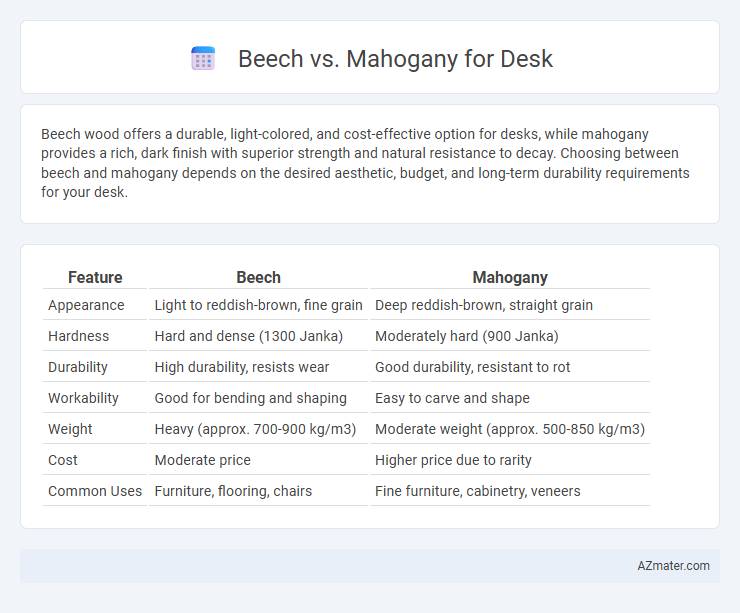Beech wood offers a durable, light-colored, and cost-effective option for desks, while mahogany provides a rich, dark finish with superior strength and natural resistance to decay. Choosing between beech and mahogany depends on the desired aesthetic, budget, and long-term durability requirements for your desk.
Table of Comparison
| Feature | Beech | Mahogany |
|---|---|---|
| Appearance | Light to reddish-brown, fine grain | Deep reddish-brown, straight grain |
| Hardness | Hard and dense (1300 Janka) | Moderately hard (900 Janka) |
| Durability | High durability, resists wear | Good durability, resistant to rot |
| Workability | Good for bending and shaping | Easy to carve and shape |
| Weight | Heavy (approx. 700-900 kg/m3) | Moderate weight (approx. 500-850 kg/m3) |
| Cost | Moderate price | Higher price due to rarity |
| Common Uses | Furniture, flooring, chairs | Fine furniture, cabinetry, veneers |
Introduction to Beech and Mahogany Desks
Beech desks are crafted from hard, dense wood known for its pale cream color and fine grain, offering durability and resistance to wear ideal for everyday office use. Mahogany desks feature rich reddish-brown tones with a smooth, elegant grain pattern that enhances luxury and timeless style in workspace furniture. Both woods provide sturdy construction, but beech delivers a lighter aesthetic while mahogany adds warmth and sophistication.
Appearance and Grain Patterns
Beech features a pale, creamy color with a fine, consistent grain pattern that offers a smooth and uniform appearance, making it ideal for minimalist or contemporary desk designs. Mahogany displays a rich, reddish-brown hue with distinctive, interlocking grain patterns, providing a luxurious and warm aesthetic that enhances traditional or classic desk styles. The contrast in color and grain complexity between beech and mahogany allows for versatile design choices depending on the desired visual impact of the desk.
Durability and Longevity
Beech wood offers excellent durability with a hard, dense grain that resists dents and scratches, making it suitable for everyday desk use. Mahogany is prized for its exceptional longevity and stability, often lasting decades without warping or cracking due to its dense, oily grain structure. While beech provides sturdy performance at a moderate price point, mahogany's superior resilience and natural resistance to moisture ensure a longer lifespan for high-end desks.
Workability and Craftsmanship
Beech wood offers excellent workability due to its fine, tight grain, allowing for precise cuts and smooth finishes ideal for detailed desk craftsmanship. Mahogany, known for its rich color and durability, also provides superior workability, enabling artisans to achieve intricate designs with ease while maintaining structural strength. Both woods are favored for high-quality desks, but beech is often preferred for projects requiring fine detail and uniform texture, whereas mahogany excels in creating elegant, timeless pieces with enhanced stability.
Cost Comparison
Beech wood desks typically cost less than mahogany due to the faster growth rate and wider availability of beech trees. Mahogany, known for its rich color and durability, commands a higher price because it is a slower-growing hardwood often sourced from tropical regions. Budget-conscious buyers often choose beech for affordable yet sturdy furniture, while those seeking premium aesthetics and longevity invest in mahogany despite the increased expense.
Environmental Impact and Sustainability
Beech wood is considered more sustainable due to its fast growth rate and abundance in temperate forests, requiring less energy for harvesting and processing compared to mahogany. Mahogany, often sourced from tropical rainforests, faces significant environmental concerns such as deforestation and habitat loss, making it less eco-friendly without certified sustainable management practices. Choosing FSC-certified beech desks supports responsible forestry and reduces ecological footprint while maintaining durability and aesthetic appeal.
Maintenance and Care Requirements
Beech wood requires regular dusting and occasional polishing to maintain its smooth surface and light, warm tone, making it relatively low-maintenance for desk use. Mahogany demands more careful upkeep, including protection from direct sunlight and periodic conditioning with specialized oils or waxes to preserve its deep reddish-brown color and prevent drying or cracking. Both woods benefit from using coasters and avoiding harsh chemicals, but mahogany's denser grain and natural oils make it more resistant to moisture damage compared to beech.
Weight and Mobility
Beech wood is significantly lighter than mahogany, making it a preferred choice for desks requiring frequent mobility or repositioning. Mahogany's higher density contributes to increased weight, providing sturdiness but limiting ease of movement. Choosing beech enhances portability without sacrificing durability, ideal for dynamic office environments.
Best Uses and Applications
Beech wood offers exceptional hardness and fine grain, making it ideal for crafting sturdy and durable desks suited for heavy daily use and modern office environments. Mahogany, prized for its rich color and natural resistance to moisture, excels in high-end, decorative desks where aesthetics and lasting beauty are paramount. For functional workspaces demanding robustness, beech is preferred, while mahogany suits executive or artistic settings emphasizing elegance and luxury.
Conclusion: Choosing the Right Wood for Your Desk
Beech offers durability and a light, consistent grain ideal for a modern, minimalist desk design, while mahogany provides rich color and classic elegance, making it perfect for a traditional or executive workspace. Consider beech for a budget-friendly, scratch-resistant option and mahogany for long-lasting beauty and increased resale value. Selecting the right wood depends on your aesthetic preferences, durability needs, and the intended style of your desk.

Infographic: Beech vs Mahogany for Desk
 azmater.com
azmater.com